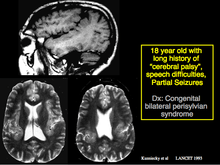Ruben Kuzniecky
| Ruben Kuzniecky, M.D. | |
|---|---|
 Ruben Kuzniecky, 2009 | |
| Born |
August 18, 1957 Panama City, Panama |
| Education | University of Buenos Aires, Montreal Neurological Institute |
| Relatives | Wife: Yvonne Kuzniecky (1983–present) |
|
Medical career | |
| Institutions | Co-Director of NYU Epilepsy Center, Director of NYU Epilepsy Research, Professor of Neurology |
Ruben Kuzniecky, M.D. is a professor of neurology at New York University (NYU) specializing in the field of epilepsy, epilepsy surgery and neuro-imaging.
He was one of the first to recognize and prove that mesial temporal sclerosis, a common cause for difficulty in controlling temporal lobe epilepsy, can be identified with MRI scans. He also described the Kuzniecky Syndrome in 1991, also known as perisylvian polymicrogyria. The syndrome is characterized by seizures, cognitive abnormalities, and a peculiar inability to use the mouth and tongue muscles. This syndrome is recognized by as a specific malformation of the brain.
Early life
Kuzniecky was born in Panama City, Republic of Panama, the son of Betzalel and Sara Kuzniecky. His parents were educators and founded and directed schools in Panama such as the Instituto Alberto Einstein and later on the Instituto Pedagogico. Kuzniecky attended the Instituto Pedagogico in Panama and graduated from the Instituto Wolfshon in Buenos Aires, Argentina. He excelled in high school as an athlete, finishing in 4th place in the 100 and 200 meter dash at the age of 16 in the Panama national school track and field championship. He entered the Universidad de Buenos Aires medical school in 1975 and graduated in 1981.
Career
After finishing medical school, Kuzniecky did a six-month stint as a research fellow at the Institute of Medical Research of the University of Buenos Aires. He then returned to Panama where he completed a one-year internship at the CSS hospital in Panama City and then went into his second year of internship in the countryside. In 1983 he was accepted to the Montreal neurological Institute, McGill University, for a neurology residency. He went into an epilepsy/EEG fellowship at the Montreal Neurological Institute under Drs. Pierre Gloor and Fred Andermann, which he completed in 1988. That year he was appointed as Assistant Professor of Neurology at the University of Alabama Birmingham, where he began his academic career. In 1992 he became Director of the UAB epilepsy center, a post he held until 2003. In 1997-1998 he was appointed as visiting professor at the Department of Physics at the University College of London, where he did magnetic resonance imaging research.
In 1997, at the age of 40, he became full professor of Neurology and Neurosurgery at UAB and served as interim chair of the Department of Neurology in 2002. In 2003 he was appointed as Professor and Co-director of NYU Epilepsy Center at NYU School of Medicine, New York. His research is centered on the use of Magnetic Resonance Imaging and its applications to epilepsy and on unraveling the major developmental brain malformations in epilepsy. He was the first to recognize and prove that mesial temporal sclerosis, a common cause for difficult epilepsy, can be identified with MRI.[1]
In the area of brain malformations, he is the co-author of the widely recognized classification scheme.[2] He has authored over 250 chapters and journal articles on a number of topics related to epilepsy. He has written two books on MRI applications in epilepsy, and more recently a patient guide, Epilepsy 101:The Ultimate Guide for Patients and Families.[3]
In 2007, Kuzniecky was co-awarded a major grant from the National Institutes of Health to organize the Epilepsy Phenome/Genome Project.[4]
Kuzniecky described the Kuzniecky Syndrome in 1991, also known as perisylvian polymicrogyria.[5] The syndrome is characterized by seizures, cognitive abnormalities, and a peculiar inability to use the mouth and tongue muscles. This syndrome is recognized by as a specific malformation of the brain.[6]

Additional research projects include the development of a brain drug delivery device to treat seizures in collaboration with Dr. Nandor Ludvig of the NYU Epilepsy Research Division.[7] He is also working with Biolert LTD from Israel to develop a watch sensor to detect convulsive seizures.[8] Kuzniecky continues to work on the Analysis of the Epilepsy Genome Phenome project through the EPi4K Genomic Discovery team. In addition, Kuzniecky, in conjunction with Dr. Daniel Lowenstein and Dr. Jacqueline French, launched the Human Epilepsy Project (HEP).[9] This project, involving 28 sites, aims to recruit 600 patients with new onset epilepsy and follow them up for five years.
In the past years, Kuzniecky began a program to help children from Panama with severe epilepsy to have access to surgical treatment by collaborating with Panama neurologist and bringing the NYU epilepsy center team to Panama's children's hospital. For a week in August 2013, in conjunction with Dr. Howard Weiner from NYU Neurosurgery, the team operated on six children with severe epilepsy.[10] The program was partially supported by Panama's first lady office of social programs.
He has been recognized for his efforts in the "Best Doctors in America" in 1995, 1998, and 2002–2016, and by the New Yorker since 2004 as one of the best doctors in the New York Metro area.[11][12] In 2013, Kuzniecky was presented with the American Registry's 'Most Compassionate Doctor' Award. He has been listed among New York Magazine's Best Doctors and Castle Connolly America's Top Doctors for several consecutive years.
Kuzniecky attends to patients with epilepsy and complex neurologic disorders at the NYU Epilepsy Center (646-558-0806). He has been recognized as a leading expert in surgery for epilepsy, epilepsy imaging and malformations of the brain and epilepsy and is widely respected in the medical community.[13]
Publications
- Kuzniecky R, Jackson G. Magnetic Resonance in Epilepsy. Raven Press, New York, 1995.
- Kuzniecky R, Jackson G. Magnetic Resonance in Epilepsy: Neuroimaging Techniques. Elsevier, Amsterdam, 2005.
- Kuzniecky R and the National Epilepsy Educational Alliance. Epilepsy 10: The Ultimate Guide for Patients and Families. Medicus Press, New Jersey, 2009
Kuzniecky R. Epilepsy Surgery: A guide for Patients and Families. Medicus Press, 2016 <https://www.amazon.com/Epilepsy-Surgery-Guide-Patients-Families-ebook/dp/B01JQZ8YVQ/ref=sr_1_fkmr0_1?ie=UTF8&qid=1479410994&sr=8-1-fkmr0&keywords=kuzniecky+r>.
Patents
- Device for Seizure Detection (Patent No. US 0082019 A1)
- Microelectrode-Equipped Subdural Therapeutic Agent Delivery Strip (Patent No. US 8868176 B2)
- "METHOD, SYSTEM, AND COMPUTER-ACCESSIBLE MEDIUM FOR CLASSIFICATION OF AT LEAST ONE ICTAL STATE (US Patent 9,443,141)
Personal life
After his move to NYU, Kuzniecky took residency in New Jersey where he lives with his wife Yvonne, family and his dogs. His three children live in New York City. He is an avid nature lover, frequently kayaking, trekking, gardening, attending his Koi fish pond, sailing and breeding and riding Peruvian horses.
References
- ↑ NeuroRx, Ruben I. Kuzniecky, Neuroimaging of Epilepsy: Therapeutic Implications Neuroimaging of Epilepsy: Therapeutic Implications
- ↑ American Academy of Neurology, A. J. Barkovich, MD, R. I. Kuzniecky, MD, G. D. Jackson, MD, R. Guerrini, MD and W. B. Dobyns, MD, Classification system for malformations of cortical development Classification system for malformations of cortical development
- ↑ Medicus Press - Home
- ↑ NYU Phenome/Genome Project
- ↑ American Academy of Neurology, Ruben Kuzniecky, MD, Frederick Andermann, MD, FRCP(C), Renzo Guerrini, MD and CBPS Multicenter Collaborative Study, The epileptic spectrum in the congenital bilateral perisylvian syndrome The epileptic spectrum in the congenital bilateral perisylvian syndrome
- ↑ The National Center for Biotechnology, Pachygyria with Mental Retardation and SeizuresOmim Entry - % 600176 - Pachygyria With Mental Retardation, Seizures, And Arachnoid Cysts
- ↑ NYU Research: Investigations
- ↑
- ↑ Human Epilepsy Project (HEP)
- ↑
- ↑ University of Alabama Press Release
- ↑ New York Magazine
- ↑